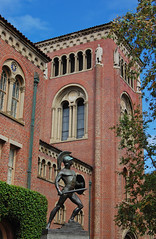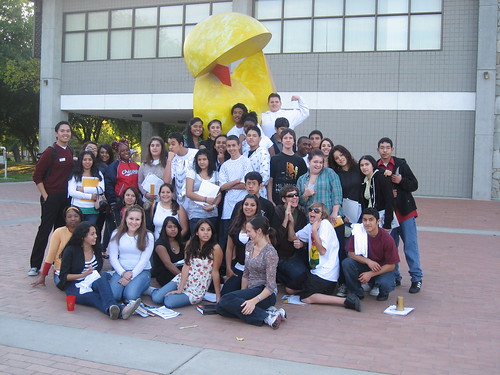 College enrollment rates are historically on the rise in the US. Stats from this fascinating book I’m currently reading, Microtrends by Mark J. Penn and Kinney Zalesne:
College enrollment rates are historically on the rise in the US. Stats from this fascinating book I’m currently reading, Microtrends by Mark J. Penn and Kinney Zalesne:
According to the National Center for Education Statistics, 69 percent of students who graudated from high school in 2005 were enrolled in college the following October. That was up from 59 percent in 1988, and up from 47 percent in 1973. Indeed, a record-high 54 percent of all Americans have been to some college. For the first time in American history, going to college is a majority expectation for families–most kids will start college–and over two-thirds of high school grads will.
Why is it that college graduation rates have stayed about the same, a paltry 66 percent for students in four-year institutions. And can you believe that that stat is dramatically lower for community colleges?
What does this mean for America today?
Well it means that although there are more Americans today entering college (which is fantastic especially because I have spent my life’s work for the past four years with BUILD and College Summit on this goal), there are also more Americans than ever dropping out, or taking a break from college, or being academically dismissed from college (for the sake of simplicity, I will just call these folks “college dropouts”).
More statistics:
- 1 in 3 Americans in their mid-20s are now college dropouts (up from 1 in 5 in the late 1960’s).
- Between 1995 and 2015, the number of undergraduate students in America is predicted to increase by 19 percent, to 16 million.
- 80% of new students will be students color (hooray!), and many will be low-income and/or first-generation college-goers (double hooray).
However, if the dropout rate stays the same (at 66%), we could be facing somewhere around 1 million additional Americans every year prepared to do college-level work but not doing it.
Remember that college graduates earn over a million more dollars over their lifetimes than high school graduates. So think of the implications of having an additional million people every year who are college-ready, but doing high school graduate-level work and earning high school graduate-level wages. And my hunch is that a good majority of college dropouts will be the students of color and/or students who are low-income/first-generation because the reasons why students drop out of college are very basic: lack of money, lack of prior education, the urgent needs of their families, etc. (among other reasons).
 Now I’m not standing here on top of my soapbox decreeing that every college dropout needs to go back to college to finish his degree because on some occasions, college may not be the right answer. I know first hand because some of the nearest and dearest to me are college dropouts of color, and they are doing fine (and are planning to go back to finish their degrees). I am saying, however, that the advantages of having a college education are extremely clear, and if we, as a nation and a community, are increasingly sending our students to college expecting them to succeed without the resources they need, then we are sending them ill-equipped and setting them up for failure. If we don’t act now, we can’t act surprised when our stellar cousin who aced all of his regular classes and got into a good state school, says that he’s not returning the following semester because he can’t afford the tuition, or he was dismissed for failing accounting.
Now I’m not standing here on top of my soapbox decreeing that every college dropout needs to go back to college to finish his degree because on some occasions, college may not be the right answer. I know first hand because some of the nearest and dearest to me are college dropouts of color, and they are doing fine (and are planning to go back to finish their degrees). I am saying, however, that the advantages of having a college education are extremely clear, and if we, as a nation and a community, are increasingly sending our students to college expecting them to succeed without the resources they need, then we are sending them ill-equipped and setting them up for failure. If we don’t act now, we can’t act surprised when our stellar cousin who aced all of his regular classes and got into a good state school, says that he’s not returning the following semester because he can’t afford the tuition, or he was dismissed for failing accounting.
Being Solutions-oriented
There are a lot of nonprofit organizations out there that prepare high school students to enter college; I mentioned BUILD and College Summit above because those are the ones that I work with now. The natural inclination that arises is to extend the resources that these similar students have been receiving into the undergraduate arena. BUILD or College Summit for undergrads? Not quite. Obviously we have to grow it up for the more adult audience, but that’s just one idea.
Students nowadays are facing enormous amounts of debt at a younger and younger age. Thirty years ago, you could graduate from UC Berkeley with barely $500 in student loans. Now, you are lucky if you graduate with $5,000 in debt, and the averages are more likely in the $15,500 for a public institution (!) and $19,400 for private universities (according to this USA Today article). Government really needs to bring back the love for students by upping grant money, and financial aid offices on campuses all over the country need to make it easier for students to access scholarships and other financial aid. And how about a mandatory course in financial management for all entering freshman… and an advanced financial management course for graduating seniors? Why is it just this year that I really learned how to keep a budget (almost four years out of college)?
 And we as a community of people of color cannot stand by and watch our fellow Americans (or American residents) fail. I hate the whole lobsters in a bucket ideology that many communities of color subscribe to, especially communities of recent immigrants (e.g. Imagine several lobsters in a bucket. When one lobster tries to climb out of the bucket, generally the lobsters below it clamor to pull it down, and, thus, no lobsters escape the bucket.) We as a community of people of color need to educate ourselves and each other, and if our younger ones are to succeed, we need to give them the resources to succeed. In the very least we need to open up their possibilities so that they can see what success looks like. What does this mean in the practical sense?
And we as a community of people of color cannot stand by and watch our fellow Americans (or American residents) fail. I hate the whole lobsters in a bucket ideology that many communities of color subscribe to, especially communities of recent immigrants (e.g. Imagine several lobsters in a bucket. When one lobster tries to climb out of the bucket, generally the lobsters below it clamor to pull it down, and, thus, no lobsters escape the bucket.) We as a community of people of color need to educate ourselves and each other, and if our younger ones are to succeed, we need to give them the resources to succeed. In the very least we need to open up their possibilities so that they can see what success looks like. What does this mean in the practical sense?
- Parents: look at your kids’ homework! Check it, and ask them the next day if they have turned it in. If you can’t help them with calculus, encourage them to go to tutoring. Teach them how to advocate for themselves at school so that they can get the resources for themselves. Man, it really is annoying when the resources are there and not being accessed by those who really need them. Teach your kids self-advocacy when they are young so when they get to college, they can actually use that skill!
- Friends who don’t have kids: check-in with your relatives. Is your little cousin on the right college track? Is she taking the right classes? How about your cousin who’s in that state college? How’s he doing? Does he need some motivation? Why don’t you take him to work one day so he can see what it’s like to be a successful college graduate. And for crying out loud, volunteer! You are not an island, and your community needs your help.
- Kids: If you’re not succeeding in a particular class or activity, tell someone. Get the help that you need. If that means less time playing Guitar Hero and one more hour of reading a book or working with a tutor, then so be it. You have all summer-long to play with your Xbox or Wii. Actually, don’t get me started with summertime; that’s a whole ‘nother tirade.
Now before you throw out celebrity examples of college dropouts who have been successful (like Bill Gates, Ellen Degeneres, etc.), my point is not that dropping out of college is a negative thing. It will happen, and statistically speaking, it’s not going to end. I am saying, however, that if our community of people wants to escape poverty and classism and is setting the expectation that our young ones are to succeed in college and in life, then we need to set them up so that they do succeed. And only we as a community of people of color can do that.
Who’s ready to help me start this new nonprofit then? Ha, just an idea. 😉
 ico.sierraclub.org/sfbaychapter
ico.sierraclub.org/sfbaychapter www.bawt.org
www.bawt.org
 College enrollment rates are historically on the rise in the US. Stats from this fascinating book I’m currently reading, Microtrends by Mark J. Penn and Kinney Zalesne:
College enrollment rates are historically on the rise in the US. Stats from this fascinating book I’m currently reading, Microtrends by Mark J. Penn and Kinney Zalesne: Now I’m not standing here on top of my soapbox decreeing that every college dropout needs to go back to college to finish his degree because on some occasions, college may not be the right answer. I know first hand because some of the nearest and dearest to me are college dropouts of color, and they are doing fine (and are planning to go back to finish their degrees). I am saying, however, that the advantages of having a college education are extremely clear, and if we, as a nation and a community, are increasingly sending our students to college expecting them to succeed without the resources they need, then we are sending them ill-equipped and setting them up for failure. If we don’t act now, we can’t act surprised when our stellar cousin who aced all of his regular classes and got into a good state school, says that he’s not returning the following semester because he can’t afford the tuition, or he was dismissed for failing accounting.
Now I’m not standing here on top of my soapbox decreeing that every college dropout needs to go back to college to finish his degree because on some occasions, college may not be the right answer. I know first hand because some of the nearest and dearest to me are college dropouts of color, and they are doing fine (and are planning to go back to finish their degrees). I am saying, however, that the advantages of having a college education are extremely clear, and if we, as a nation and a community, are increasingly sending our students to college expecting them to succeed without the resources they need, then we are sending them ill-equipped and setting them up for failure. If we don’t act now, we can’t act surprised when our stellar cousin who aced all of his regular classes and got into a good state school, says that he’s not returning the following semester because he can’t afford the tuition, or he was dismissed for failing accounting. And we as a community of people of color cannot stand by and watch our fellow Americans (or American residents) fail. I hate the whole lobsters in a bucket ideology that many communities of color subscribe to, especially communities of recent immigrants (e.g. Imagine several lobsters in a bucket. When one lobster tries to climb out of the bucket, generally the lobsters below it clamor to pull it down, and, thus, no lobsters escape the bucket.) We as a community of people of color need to educate ourselves and each other, and if our younger ones are to succeed, we need to give them the resources to succeed. In the very least we need to open up their possibilities so that they can see what success looks like. What does this mean in the practical sense?
And we as a community of people of color cannot stand by and watch our fellow Americans (or American residents) fail. I hate the whole lobsters in a bucket ideology that many communities of color subscribe to, especially communities of recent immigrants (e.g. Imagine several lobsters in a bucket. When one lobster tries to climb out of the bucket, generally the lobsters below it clamor to pull it down, and, thus, no lobsters escape the bucket.) We as a community of people of color need to educate ourselves and each other, and if our younger ones are to succeed, we need to give them the resources to succeed. In the very least we need to open up their possibilities so that they can see what success looks like. What does this mean in the practical sense? I’ve been listening to a great podcast series from the
I’ve been listening to a great podcast series from the 
